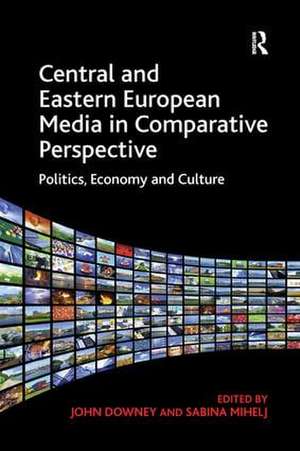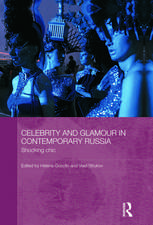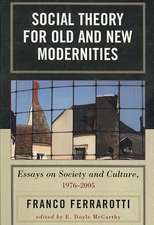Central and Eastern European Media in Comparative Perspective: Politics, Economy and Culture
Autor Sabina Mihelj Editat de John Downeyen Limba Engleză Paperback – 27 feb 2017
| Toate formatele și edițiile | Preț | Express |
|---|---|---|
| Paperback (1) | 463.19 lei 43-57 zile | |
| Taylor & Francis – 27 feb 2017 | 463.19 lei 43-57 zile | |
| Hardback (1) | 1054.71 lei 43-57 zile | |
| Taylor & Francis – 28 ian 2012 | 1054.71 lei 43-57 zile |
Preț: 463.19 lei
Nou
Puncte Express: 695
Preț estimativ în valută:
88.63€ • 92.77$ • 73.77£
88.63€ • 92.77$ • 73.77£
Carte tipărită la comandă
Livrare economică 31 martie-14 aprilie
Preluare comenzi: 021 569.72.76
Specificații
ISBN-13: 9781138256934
ISBN-10: 1138256935
Pagini: 214
Dimensiuni: 156 x 234 x 12 mm
Greutate: 0.31 kg
Ediția:1
Editura: Taylor & Francis
Colecția Routledge
Locul publicării:Oxford, United Kingdom
ISBN-10: 1138256935
Pagini: 214
Dimensiuni: 156 x 234 x 12 mm
Greutate: 0.31 kg
Ediția:1
Editura: Taylor & Francis
Colecția Routledge
Locul publicării:Oxford, United Kingdom
Notă biografică
John Downey is Reader in Comparative Media at Loughborough University, UK. He has written widely on new media, the public sphere, and comparative media and in n 2007 he was named as one of the fifty leading communication scholars in Europe by Communication Director magazine. Sabina Mihelj is Lecturer in Media, Communication and Culture at Loughborough University. Her research focuses on issues of collective identity and mass communication, comparative media research and the cultural and social history of Cold War media.
Recenzii
'... written by "inside" and "outside" experts on Central-East European media, this volume provides a thorough assessment of political, economic, and cultural challenges, as well as consequences of, the development of European post-communist media systems over the last twenty years.' Slavko Splichal, University of Ljubljana, Slovenia 'Why do we have the media we have? This question posed by the editors provides a central theme which their work successfully seeks to address. The contributors to this volume try to explain the nature of the media in Central and Eastern Europe with original, interpretive approaches to this question. One of the main strengths of the book is that the answers they give are based on facts and data rather than opinions.' Paolo Mancini, Università di Perugia, Italy 'The editors have consciously chosen to commission chapters from a selection of academics whose approaches are contrasting, starting from widely different premises. In this book we have taken to heart the task of explaining why we have the media we have. Tied up with this is necessarily a critique of mediacentrism. If we wish to explain why the media are as they are we need to look at the outside of the media as well as inside. No-one can accuse them of failing to meet this objective... this is a useful and informative set of insights into how our European neighbours’ media landscapes are not so very different from our own.' LSE Review of Books 'The collection is an informative and valuable addition to an array of media studies on an issue intimately tied to the democratic evolution of long-suffering countries that have never experienced the pangs of democracy’s establishment, with the singular exception of the short-lived democratic experiment in Czechoslovakia in the 1920s-1930s. Most important, along with other scholarship on the media in central and eastern Europe, this volume suggests the void(s) yet to be filled: a cultural approach to provide a deeper and mor
Cuprins
Introduction Comparing Media Systems in Central and Eastern Europe, SabinaMihelj, JohnDowney; Chapter 1 Post-communist Political Systems and Media Freedom and Independence, KarolJakubowicz; Chapter 2 The Interplay of Politics and Economics in Transitional Societies, ColinSparks; Chapter 3 Between Segmentation and Integration, SabinaMihelj; Chapter 4 Gender (In)equity in Post-socialist Media, MojcaPajnik; Chapter 5 Transnational Capital, Media Differentiation, and Institutional Isomorphism in Central and Eastern European Media Systems, JohnDowney; Chapter 6 Transnational Media Regulation in Central and Eastern Europe, AlisonHarcourt; Chapter 7 Back to the Local? Transnational Media Flows and Audience Consumption Patterns in Central and Eastern Europe, VáclavŠt?tka; Chapter 101 Conclusion, JohnDowney, SabinaMihelj;
Descriere
An international line up of distinguished experts and emerging scholars methodically examine the different economic, political, cultural, and transnational factors affecting developments in media systems across Central and Eastern Europe. Whereas earlier works in the media system tradition have, in the main, adopted the political framework of comparative politics, the authors argue that media systems are also cultural and economic institutions and there are other critical variables that might explain certain outcomes better. Topics discussed range from political economy to gender inequality to the study of ethno-cultural diversity.


















